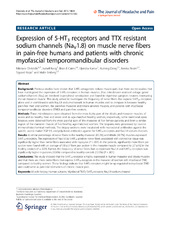| dc.contributor.author | Christidis, Nikolaos | en_US |
| dc.contributor.author | Kang, Isabell | en_US |
| dc.contributor.author | Cairns, Brian E. | en_US |
| dc.contributor.author | Kumar, Ujendra | en_US |
| dc.contributor.author | Dong, Xudong | en_US |
| dc.contributor.author | Rosén, Annika | en_US |
| dc.contributor.author | Kopp, Sigvard | en_US |
| dc.contributor.author | Ernberg, Malin | en_US |
| dc.date.accessioned | 2015-08-04T11:46:52Z | |
| dc.date.available | 2015-08-04T11:46:52Z | |
| dc.date.issued | 2014-09-26 | |
| dc.identifier.issn | 1129-2369 | |
| dc.identifier.uri | https://hdl.handle.net/1956/10202 | |
| dc.description.abstract | Background: Previous studies have shown that 5-HT3-antagonists reduce muscle pain, but there are no studies that have investigated the expression of 5-HT3-receptors in human muscles. Also, tetrodotoxin resistant voltage gated sodium-channels (NaV) are involved in peripheral sensitization and found in trigeminal ganglion neurons innervating the rat masseter muscle. This study aimed to investigate the frequency of nerve fibers that express 5-HT3A-receptors alone and in combination with NaV1.8 sodium-channels in human muscles and to compare it between healthy pain-free men and women, the pain-free masseter and tibialis anterior muscles, and patients with myofascial temporomandibular disorders (TMD) and pain-free controls. Methods: Three microbiopsies were obtained from the most bulky part of the tibialis and masseter muscles of seven and six healthy men and seven and six age-matched healthy women, respectively, while traditional open biopsies were obtained from the most painful spot of the masseter of five female patients and from a similar region of the masseter muscle of five healthy, age-matched women. The biopsies were processed by routine immunohistochemical methods. The biopsy sections were incubated with monoclonal antibodies against the specific axonal marker PGP 9.5, and polyclonal antibodies against the 5-HT3A-receptors and NaV1.8 sodium-channels. Results: A similar percentage of nerve fibers in the healthy masseter (85.2%) and tibialis (88.7%) muscles expressed 5-HT3A-receptors. The expression of NaV1.8 by 5-HT3A positive nerve fibers associated with connective tissue was significantly higher than nerve fibers associated with myocytes (P < .001). In the patients, significantly more fibers per section were found with an average of 3.8 ± 3 fibers per section in the masseter muscle compared to 2.7 ± 0.2 in the healthy controls (P = .024). Further, the frequency of nerve fibers that co-expressed NaV1.8 and 5-HT3A receptors was significantly higher in patients (42.6%) compared to healthy controls (12.0%) (P < .001). Conclusions: This study showed that the 5-HT3A-receptor is highly expressed in human masseter and tibialis muscles and that there are more nerve fibers that express 5-HT3A-receptors in the masseter of women with myofascial TMD compared to healthy women. These findings indicate that 5-HT3-receptors might be up-regulated in myofascial TMD and could serve as potential biomarkers of chronic muscle pain. | en_US |
| dc.language.iso | eng | eng |
| dc.publisher | Springer | eng |
| dc.rights | Attribution CC BY | eng |
| dc.rights.uri | http://creativecommons.org/licenses/by/4.0 | eng |
| dc.subject | Muscle biopsy | eng |
| dc.subject | Human subjects | eng |
| dc.subject | Myofascial TMD | eng |
| dc.subject | 5-HT3-receptor | eng |
| dc.subject | NaV1.8 sodium channel | eng |
| dc.title | Expression of 5-HT3 receptors and TTX resistant sodium channels (Nav1.8) on muscle nerve fibers in pain-free humans and patients with chronic myofascial temporomandibular disorders | en_US |
| dc.type | Peer reviewed | |
| dc.type | Journal article | |
| dc.date.updated | 2015-08-04T11:40:57Z | |
| dc.description.version | publishedVersion | en_US |
| dc.rights.holder | Copyright 2014 Christidis et al.; licensee Springer | |
| dc.source.articlenumber | 63 | |
| dc.identifier.doi | https://doi.org/10.1186/1129-2377-15-63 | |
| dc.identifier.cristin | 1218996 | |
| dc.source.journal | The Journal of Headache and Pain | |
| dc.source.40 | 15 | |

